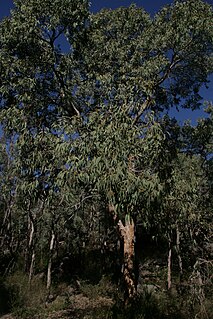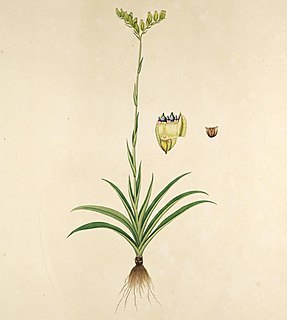Related Research Articles

The Scorpaeniformes are a diverse order of ray-finned fish, including the lionfishes and sculpins, but have also been called the Scleroparei. It is one of the five largest orders of bony fishes by number of species, with over 1,320.

Myliobatiformes is one of the four orders of batoids, cartilaginous fishes related to sharks. They were formerly included in the order Rajiformes, but more recent phylogenetic studies have shown the myliobatiforms to be a monophyletic group, and its more derived members evolved their highly flattened shapes independently of the skates.

A savanna or savannah is a mixed woodland-grassland ecosystem characterised by the trees being sufficiently widely spaced so that the canopy does not close. The open canopy allows sufficient light to reach the ground to support an unbroken herbaceous layer consisting primarily of grasses.
A soil type is a taxonomic unit in soil science. All soils that share a certain set of well-defined properties form a distinctive soil type. Soil type is a technical term of soil classification, the science that deals with the systematic categorization of soils. Every soil of the world belongs to a certain soil type. Soil type is an abstract term. In nature, you will not find soil types. You will find soils that belong to a certain soil type.

The Atheriniformes, also known as the silversides, are an order of ray-finned fishes that includes the Old World silversides and several less-familiar families, including the unusual Phallostethidae. The order includes at least 354 species. They are found worldwide in tropical and temperate marine and freshwater environments.
USDA soil taxonomy (ST) developed by the United States Department of Agriculture and the National Cooperative Soil Survey provides an elaborate classification of soil types according to several parameters and in several levels: Order, Suborder, Great Group, Subgroup, Family, and Series. The classification was originally developed by Guy Donald Smith, former director of the U.S. Department of Agriculture's soil survey investigations.

Soil classification deals with the systematic categorization of soils based on distinguishing characteristics as well as criteria that dictate choices in use.

In soil science, podzols are the typical soils of coniferous or boreal forests and also the typical soils of eucalypt forests and heathlands in southern Australia. In Western Europe, podzols develop on heathland, which is often a construct of human interference through grazing and burning. In some British moorlands with podzolic soils, cambisols are preserved under Bronze Age barrows.
A soil horizon is a layer parallel to the soil surface whose physical, chemical and biological characteristics differ from the layers above and beneath. Horizons are defined in many cases by obvious physical features, mainly colour and texture. These may be described both in absolute terms and in terms relative to the surrounding material, i.e. 'coarser' or 'sandier' than the horizons above and below.

Ceratopetalum apetalum, the coachwood, scented satinwood or tarwood, is a medium-sized hardwood tree, straight-growing with smooth, fragrant, greyish bark. It is native to eastern Australia in the central and northern coastal rainforests of New South Wales and southern Queensland, where is often found on poorer quality soils in gullies and creeks and often occurs in almost pure stands. C. apetalum is one of 8 species of Ceratopetalum occurring in eastern Australia, New Guinea, New Britain and various islands in the same region.

Thismiaceae is a family of flowering plants whose status is currently uncertain. The Angiosperm Phylogeny Group classifications merge Thismiaceae into Burmanniaceae, noting that some studies have suggested that Thismiaceae, Burmanniaceae and Taccaceae should be separate families, whereas others support their merger.

Banksia repens, the creeping banksia, is a species of shrub in the plant genus Banksia. It occurs on the south coast of Western Australia from D'Entrecasteaux National Park in the west to Mount Ragged in the east.

Banksia violacea, commonly known as violet banksia, is a species of shrub or tree in the plant genus Banksia. It generally grows as a small shrub to 1.5 m (5 ft) high with fine narrow leaves, and is best known for its unusually coloured dark purple-violet inflorescences. The colour of the inflorescences, short leaves, and flattened follicles which are sticky when young, help identify this species from others in the field. It is found in low shrubland in southern regions of Western Australia from Esperance in the east to Narrogin in the west, growing exclusively in sandy soils.

Diplacodes haematodes, the scarlet percher, is a species of dragonfly in the family Libellulidae. It occurs throughout Australia, Timor, New Guinea, Vanuatu, and New Caledonia. It is locally common in habitats with hot sunny exposed sites at or near rivers, streams, ponds, and lakes. It often prefers to settle on hot rocks rather than twigs or leaves, and is quite wary. This is a spectacular species of dragonfly, although small in size. The male is brilliant red, the female yellow-ochre. Females have yellow infuscation suffusing the outer wings, while the males have similar colour at the bases of the wings.
The Canadian System of Soil Classification is more closely related to the American system than any other, but they differ in several ways. The Canadian system is designed to cover only Canadian soils. The Canadian system dispenses with the sub-order hierarchical level. Solonetzic and Gleysolic soils are differentiated at the order level.

In geology, a slickenside is a smoothly polished surface caused by frictional movement between rocks along the two sides of a fault. This surface is normally striated in the direction of movement. The plane may be coated by mineral fibres that grew during the fault movement, known as slickenfibres, which also show the direction of displacement. Due to irregularities in the fault plane exposed slickenfibres typically have a stepped appearance that can be used to determine the sense of movement across the fault. The surface feels smoother when the hand is moved in the same direction that the eroded side of the fault moved, as the surface steps down in that direction, like the scales on a fish when stroked from the head.

Corymbia eximia, commonly known as the yellow bloodwood, is a bloodwood native to New South Wales. It occurs around the Sydney Basin often in high rainfall areas on shallow sandstone soils on plateaux or escarpments, in fire prone areas. Growing as a gnarled tree to 20 m (66 ft), it is recognisable by its distinctive yellow-brown tessellated bark. The greyish green leaves are thick and veiny, and lanceolate spear- or sickle-shaped. The cream flowerheads grow in panicles in groups of seven and appear in spring. Known for many years as Eucalyptus eximia, the yellow bloodwood was transferred into the new genus Corymbia in 1995 when it was erected by Ken Hill and Lawrie Johnson. It is still seen under the earlier name in some works.
The Handbook of Australian Soils is a soil classification system developed for Australian soils. The first edition was published in 1968 and is based on the great soil group classification system published by J. A. Prescott in 1931. It has since been superseded by the Australian Soil Classification.
The term “duplex” is used in Australia for soils with contrasting texture between soil horizons, although such soils are found in other parts of the world. Duplex soils are also termed “texture contrast soils”.

BurmannialesMart. was an order of monocotyledons, subsequently discontinued.
References
- ↑ "Australian Soil Classification (as Online Interactive Key)". CSIRO. Retrieved 11 February 2016.
- ↑ Isbell, Raymond F. (1996). The Australian Soil Classification (1st ed.). Collingwood, Victoria: CSIRO Publishing. ISBN 0-643-05813-3.
- ↑ Isbell, Raymond F. (2002). The Australian Soil Classification (Revised ed.). Collingwood, Victoria: CSIRO Publishing. ISBN 0-643-06898-8.
- ↑ CSIRO. "How to Classify". The Australian Soil Classification. Retrieved 13 July 2010.
- ↑ The National Committee on Soil and Terrain (2 June 2021). "The Australian Soil Classification". Soil Science Australia. Archived from the original on 2021-05-10. Retrieved 2 June 2021.
- 1 2 Northcote, Keith H. (1960). A factual key for the recognition of Australian soils. Divisional Report No. 4/60. CSIRO Division of Soils.
- ↑ Northcote, Keith H. (1971). A factual key for the recognition of Australian soils (3rd ed.). Glenside, South Australia: Rellim Technical Publications.
- ↑ Stace, H.C.T.; Hubble, G.D.; Brewer, R; Northcote, K.H.; Sleeman, J.R.; Mulcahy, M.J.; Hallsworth, E.G. (1968). A Handbook of Australian Soils. Glenside, South Australia: Rellim Technical Publications.
- ↑ Fitzpatrick, R.W.; Powell, B.; McKenzie, N.J.; Maschmedt, D.J.; Schoknecht, N. (2003). "Demands on soil classification in Australia". In Eswaran, H.; Rice, T.; Ahrens, R.; Stewart, B.A. (eds.). Soil Classification: A Global Desk Reference. Boca Raton, Florida: CRC Press. ISBN 0-8493-1339-2.
- ↑ CSIRO. "Colour Classes". The Australian Soil Classification. Retrieved 14 July 2010.
- ↑ CSIRO. "Hydrosols". The Australian Soil Classification. Retrieved 14 July 2010.
- ↑ CSIRO. "Rudosols". The Australian Soil Classification. Retrieved 14 July 2010.
